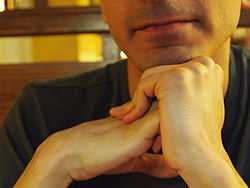Cracking joints

Cracking or popping of joints is the action of joint manipulation to produce a sharp cracking or popping sound. This commonly occurs during deliberate knuckle-cracking. It is possible to crack many joints, such as those in the back and neck vertebrae, hips, wrists, elbows, shoulders, toes, ankles, knees, jaws, feet, sternum, and the Achilles tendon area. Although it is a common folk belief that popping of joints, especially knuckles, leads to arthritis or other joint problems, medical research has so far failed to conclusively demonstrate any connection between knuckle cracking and long-term joint problems.
Causes

The physical mechanism causing a cracking sound produced by bending, twisting, or compressing joints is uncertain. Suggested causes include:
- Cracking sounds occur when bubbles form in joints as they are pulled apart <ref = "kawchuk">Gregory N. Kawchuk, Jerome Fryer, Jacob L. Jaremko, Hongbo Zeng, Lindsay Rowe, Richard Thompson (2015). "Real-Time Visualization of Joint Cavitation". J] 25 (6): 384–390. PMID 12183696. Text " DOI: 10.1371/journal.pone.0119470 " ignored (help)</ref>
- Cavitation within the joint—small cavities of partial vacuum form in the synovial fluid and then rapidly collapse, producing a sharp sound.
- Rapid stretching of ligaments.[1]
- Intra-articular (within-joint) adhesions being broken.[1]
There were several theories to explain the cracking of joints. Synovial fluid cavitation has some evidence to support it.[2] When a spinal manipulation is performed, the applied force separates the articular surfaces of a fully encapsulated synovial joint, which in turn creates a reduction in pressure within the joint cavity. In this low-pressure environment, some of the gases that are dissolved in the synovial fluid (which are naturally found in all bodily fluids) leave the solution, making a bubble, or cavity, which rapidly collapses upon itself, resulting in a "clicking" sound.[3] The contents of the resultant gas bubble are thought to be mainly nitrogen.[4] The effects of this process will remain for a period of time known as the "refractory period," during which the joint cannot be "re-cracked," which lasts about twenty minutes, while the gases are slowly reabsorbed back into the synovial fluid. There is some evidence that ligament laxity may be associated with an increased tendency to cavitate.[5]
However, recent evidence demostrates that the cracking sound is produced when the bubble within the joint is formed, not when it collapses. <ref = "kawchuk">Gregory N. Kawchuk, Jerome Fryer, Jacob L. Jaremko, Hongbo Zeng, Lindsay Rowe, Richard Thompson (2015). "Real-Time Visualization of Joint Cavitation". J] 25 (6): 384–390. PMID 12183696. Text " DOI: 10.1371/journal.pone.0119470 " ignored (help)</ref>
The snapping of tendons or scar tissue over a prominence (as in snapping hip syndrome) can also generate a loud snapping or popping sound.[1]
Effects

The common claim that cracking one's knuckles causes arthritis appears unsupported. A study published in 2011 examined the hand radiographs of 215 people (aged 50 to 89) and compared the joints of those who regularly cracked their knuckles to those who did not.[6] The study concluded that knuckle-cracking did not cause hand osteoarthritis, no matter how many years or how often a person cracked their knuckles.[6] An earlier study also concluded that there was no increased preponderance of arthritis of the hand of chronic knuckle-crackers; however, habitual knuckle-crackers were more likely to have hand swelling and lowered grip strength.[7] Habitual knuckle-cracking was associated with manual labour, biting of the nails, smoking, and drinking alcohol and was suggested to result in functional hand impairment.[7] This early study has been criticized for not taking into consideration the possibility of confounding factors, such as whether the ability to crack one's knuckles is associated with impaired hand functioning rather than being a cause of it.[8]
There are many ways people have learned to crack the joints of their fingers, one of the most common ways is to put pressure on the joint between the metacarpals and the proximal phalanges.
Medical doctor Donald Unger cracked the knuckles of his left hand every day for more than sixty years, but he did not crack the knuckles of his right hand. No arthritis or other ailments formed in either hand, earning him the 2009 Ig Nobel Prize in Medicine, a parody of the Nobel Prize.[9]
See also
- Crepitus – sounds made by joints
- Joint manipulation
References
- ↑ 1.0 1.1 1.2 Protopapas M, Cymet T, Protapapas M (1 May 2002). "Joint cracking and popping: understanding noises that accompany articular release.". J Am Osteopath Assoc 102 (5): 283–7. PMID 12033758.
- ↑ Brodeur R. (1995). "The audible release associated with joint manipulation.". J Manipulative Physiol Ther 18 (3): 155–64. PMID 7790795.
- ↑ Maigne, Jean-Yves; Vautravers, Philippe (September 2003). "Mechanism of action of spinal manipulative therapy". Joint Bone Spine 70 (5): 336–341. doi:10.1016/S1297-319X(03)00074-5.
- ↑ Unsworth A, Dowson D, Wright V. (1971). "'Cracking joints'. A bioengineering study of cavitation in the metacarpophalangeal joint.". Ann Rheum Dis 30 (4): 348–58. doi:10.1136/ard.30.4.348. PMC 1005793. PMID 5557778.
- ↑ Fryer, Gary and Jacob, Mudge and McLaughlin, Patrick (2002). "The Effect of Talocrural Joint Manipulation on Range of Motion at the Ankle". Journal of Manipulative and Physiological Therapeutics 25 (6): 384–390. doi:10.1067/mmt.2002.126129. PMID 12183696.
- ↑ 6.0 6.1 Deweber K, Olszewski M, Ortolano R. (2011). "Knuckle cracking and hand osteoarthritis". J Am Board Fam Med 24 (2): 169–174. doi:10.3122/jabfm.2011.02.100156. PMID 21383216.
- ↑ 7.0 7.1 Castellanos J., Axelrod D. (1990). "Effect of habitual knuckle cracking on hand function". Annals of the Rheumatic Diseases 49 (5): 49(5):308–9. doi:10.1136/ard.49.5.308. PMC 1004074. PMID 2344210.
- ↑ Simkin, Peter (November 1990). "Habitual knuckle cracking and hand function.". Annals of Rheumatic Disease 49 (11): 957. doi:10.1136/ard.49.11.957-b.
- ↑ "2009 Winners of the Ig® Nobel Prize". Retrieved 27 November 2011.